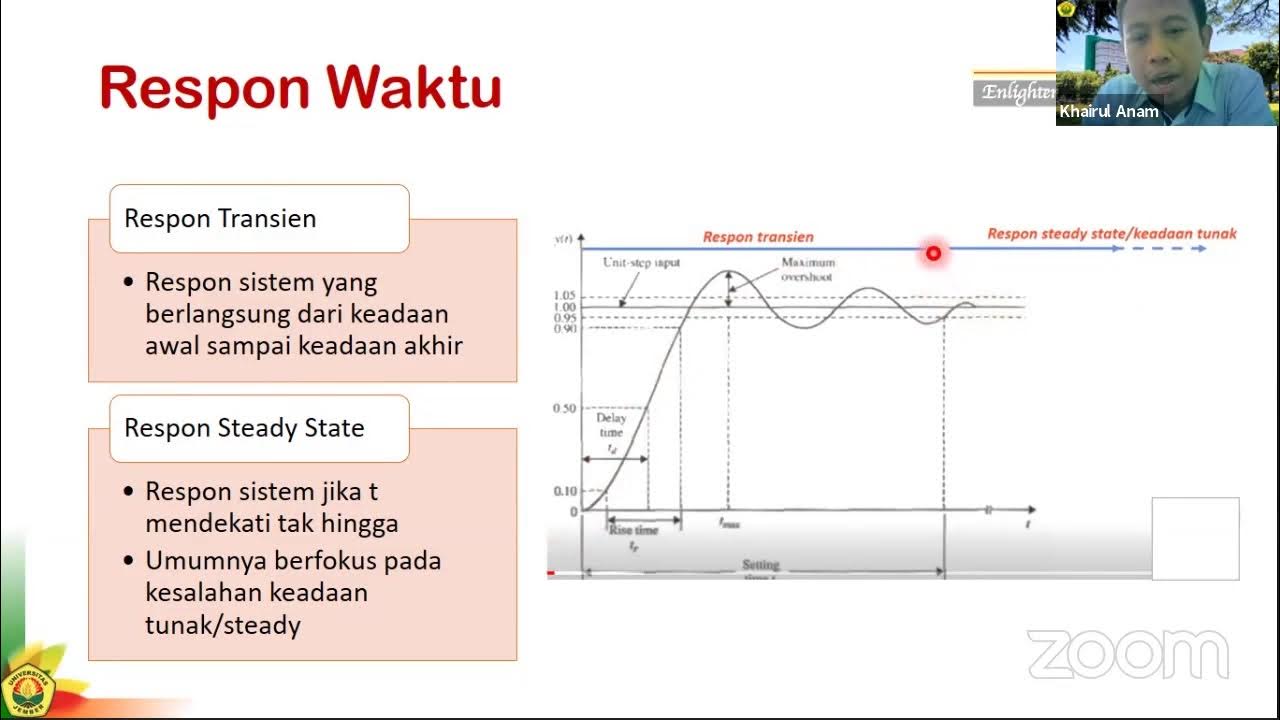RANGKAIAN LISTRIK : Respons Alami dan Respons Steady State ( Part 25 )
Summary
TLDRIn this educational video, the speaker explains the fundamentals of electrical circuits, focusing on the concepts of natural response, steady-state response, forced response, and transient response. Using a practical circuit problem involving capacitors, resistors, and voltage sources, the video walks viewers through the steps of analyzing circuit behavior over time. The speaker provides clear explanations of key terms and methods, offering a hands-on approach to understanding how electrical components respond to changes in voltage. This video aims to help students grasp complex electrical concepts through easy-to-follow instructions and real-world examples.
Takeaways
- 😀 Natural response refers to the behavior of a circuit based on the energy stored in components like capacitors and inductors.
- 😀 Steady-state response is the long-term behavior of the circuit after it has settled with constant input, such as a DC voltage.
- 😀 Forced response occurs due to external sources, such as multiple voltage sources driving the circuit.
- 😀 Transient response describes the temporary behavior of a circuit when adjusting to a new input or condition, like when the circuit is powered on or off.
- 😀 Capacitors in steady-state behave as an open circuit when DC voltage is applied long enough, causing them to stabilize in voltage.
- 😀 To analyze the voltage across a capacitor, we use the voltage divider rule when the circuit is in steady-state conditions.
- 😀 The initial capacitor voltage at time t = 0 can be calculated by applying the voltage divider formula: V_C = (R2 / (R2 + R1)) × V_source.
- 😀 When analyzing for t > 0, we consider the capacitor’s discharge behavior, which follows an exponential decay curve based on the resistor and capacitor values.
- 😀 Kirchhoff's Voltage Law (KVL) and Kirchhoff's Current Law (KCL) are applied to form a differential equation to model the circuit behavior over time.
- 😀 The differential equation governing the capacitor's voltage is of first-order linear form, represented as dV_C/dt + (1/RC) × V_C = 0.
- 😀 Understanding natural and steady-state responses is essential for accurately predicting circuit behavior in electrical engineering problems.
Q & A
What is the natural response of a circuit?
-The natural response of a circuit refers to the behavior that depends solely on the energy stored in circuit elements such as capacitors and inductors. It represents how the system reacts when the external driving source is removed.
How does a capacitor behave when a voltage source is applied to it?
-When a voltage source is applied to a capacitor, the capacitor stores charge, and the voltage across the capacitor increases according to an exponential curve, depending on the capacitance and the resistance in the circuit.
What happens to a capacitor when the voltage source is suddenly disconnected?
-When the voltage source is disconnected, the capacitor discharges its stored energy, and its behavior can be analyzed by examining the exponential decay of the voltage across it.
What is the steady-state response of a circuit?
-The steady-state response refers to the behavior of the circuit after a long period when it has settled into a stable condition, typically when a continuous voltage is applied, and the system reaches a stable voltage or current.
How can you determine the steady-state voltage across a capacitor in a circuit?
-To determine the steady-state voltage across a capacitor, you examine the circuit after a long time, where the capacitor acts as an open circuit for DC sources, and you use techniques like voltage division to calculate the voltage.
What is the forced response in an electrical circuit?
-The forced response is the behavior of the circuit that results from one or more independent sources driving the system, such as external voltage or current sources, influencing the system’s response.
What is a transient response in electrical circuits?
-The transient response refers to the temporary behavior of the circuit during the period when the system is adjusting from an initial state to the steady-state condition, typically characterized by exponential growth or decay.
In the provided example, how is the voltage across the capacitor at t = 0 calculated?
-At t = 0, when the circuit is in steady-state, the voltage across the capacitor is calculated using the voltage divider rule, taking into account the resistors and the source voltage.
Why does the circuit behave differently after t = 0 when analyzing the capacitor's voltage?
-After t = 0, the behavior changes because the capacitor is no longer influenced by the external voltage source. The capacitor now discharges, and its behavior is influenced by the rest of the circuit components, and the system enters a transient state.
What role does impedance play in this analysis, especially concerning a DC voltage source?
-Impedance is used to describe how a component resists the flow of current. In the case of a DC voltage source, the impedance of a capacitor is infinite (open circuit), meaning no current can flow through the capacitor in steady-state conditions for DC voltage.
Outlines

此内容仅限付费用户访问。 请升级后访问。
立即升级Mindmap

此内容仅限付费用户访问。 请升级后访问。
立即升级Keywords

此内容仅限付费用户访问。 请升级后访问。
立即升级Highlights

此内容仅限付费用户访问。 请升级后访问。
立即升级Transcripts

此内容仅限付费用户访问。 请升级后访问。
立即升级浏览更多相关视频

Electrical Engineering: Ch 8: RC & RL Circuits (29 of 43) Natural Response and Forced Response

System Response Characteristics

Electrical Engineering: Ch 8: RC & RL Circuits (35 of 65) Step Response of an RL Circuit

Sistem Kontrol #3a: Analisis Repon Sistem - Pendahuluan

Frequency response Part 1

Sistem Kontrol #3b: Analisis Respon Waktu Sistem Orde 1
5.0 / 5 (0 votes)
